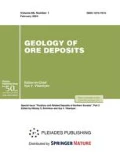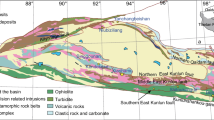Abstract
The estimation of the long-term stability of crystalline rock massifs with respect to natural and technogenic loads in the course of long-term storage of spent nuclear fuel (SNF) is a special area of surveys at underground research laboratories (URLs). In parallel with these surveys, data on uranium deposits—natural analogues of repositories of SNF consisting of 95% UO2—are used for obtaining insight into the dynamics of radionuclide migration and validating barrier properties of host rocks. Examples of URLs located in granitic massifs of Sweden (Äspö), Canada (Whiteshell), Switzerland (Grimsel), Japan (Mizunami), and Finland (ONKALO), as well as the El Berrocal (Spain), Palmottu (Finland), Sanerliu (China), and Kamaishi (Japan) deposits, are considered in the paper. The objects listed above are distinct in tectonic settings, geology, control of ore mineralization, redox conditions of uranium migration, and character and intensity of filtration and transportation, which predetermine the direction and specific features of research conducted therein. A variant in which a URL and a natural analogue are combined in one object is especially promising for validation of safe long-term isolation of SNF. The Antei vein-stockwork uranium deposit in the southeastern Transbaikal region, localized in Paleozoic granite at a depth of 400–1000 m and opened by mine workings at six levels, is such an object. Its geological features, stress-strain state, and infrastructure of mine workings offer an opportunity to study the entire spectrum of processes proceeding in near-and far-field of an SNF repository. The structural geology, mineralogy and petrography, and petrophysical and tectonophysical features of the deposit at its three lower levels are considered. The sequence of metasomatic alteration of rocks and the dynamics of formation of ore-bearing faults that crosscut prototectonic elements, as well as relationships of physicomechanical properties of rocks as a function of the intensity of their metasomatic alteration and the distance from master fault planes, have been established. A 3D geological model of the deposit in combination with estimated parameters of the present-day stress field and physicomechanical properties of particular rock blocks serves as the basis for prediction of the geomechanical behavior of the massif. The practical implications of the results obtained for assessment of the long-term safety of SNF repositories in granites are discussed.
Similar content being viewed by others
References
O. V. Andreeva and V. A. Golovin, “Metasomatic Processes at Uranium Deposits of the Tulukui Caldera, Eastern Transbaikal Region, Russia,” Geol. Rudn. Mestorozhd. 40(3), 205–220 (1998) [Geol. Ore Deposits 40 (3), 184–196 (1998)].
O. V. Andreeva, V. A. Golovin, P. S. Kozlova, et al., “Evolution of Mesozoic Magmatism and Ore-Metasomatic Processes in the Southeastern Transbaikal Region, Russia,” Geol. Rudn. Mestorozhd. 382(2), 115–130 (1996) [Geol. Ore Deposits 382 (2), 101–113 (1996)].
D. Ask, “Evaluation of Measurement-Related Uncertainties in the Analysis of Overcoring Rock Stress Data from Äspö HRL, Sweden: A Case Study,” Int. J. Rock Mech. Min. Sci., No. 40, 1173–118 (2003).
Äspö Hard Rock Laboratory: 10 Years of Research (SKB, Stockholm, 1996).
R. Blomqvist, T. Ruskeeniemi, J. Kaija, et al., The Palmottu Natural Analogue Project. Phase II: Transport of Radionuclides in a Natural Flow System at Palmottu (European Commission Report 19611, 2000).
J. Bruno, L. Duro, and M. Grive, “The Applicability and Limitations of Thermodynamic Geochemical Models to Simulate Trace Element Behavior in Natural Waters. Lessons Learned from Natural Analogue Studies,” J. Chem. Geol 190, 371–393 (2002).
El Berrocal Project: Characterization and Validation of Natural Radionuclide Migration Processes Under Real Conditions on the Fissured Granitic Environment. Geological Studies (ENRESA, Madrid, 1996), Vol. 1.
R. Everitt, A. Brown, R. Ejeckam, et al., “Litho-Structural Layering within the Archean Lac du Bonnet Batholith, at AECL’s Underground Research Laboratory, Southeastern Manitoba,” J. Struct. Geol. 20(9/10), 1291–1304 (1998).
U. Frick and W. R. Alexander, The Radionuclide Migration Experiment—Overview of Investigations 1985–1990 (NAGRA Techn. Rep. NTB 91-04, Wettingen, Switzerland, 1992).
B. Frieg, W. R. Alexander, H. Dollinger, et al., “In Situ Resin Impregnation for Investigating Radionuclide Retardation in Fractured Porosity Host Rocks,” J. Contam. Hydrol. 35, 115–130 (1998).
Guidelines on Research and Development in Relation to Geological Disposal of High-Level Radioactive Waste in Japan (Atomic Energy Commission of Japan, 1997).
A. Hagros, K. Äikäs, T. McEwen, and P. Anttila, Host Rock Classification, Phase 3: Proposed Classification. System (HRC-System) (Posiva Oy Rep. 2005-07, Olkiluoto, 2005).
J. Hammer, J. Behlau, and G. Mingerzahn, “Teilgebiet ‘Kamennyj’: 3D-Modellierung der Geologisch-Geophysikalischen Erkundungsergebnisse Mittels ‘Open-Geo’,” in Proceedings of RW Disposal Conference (DBE-VNIPIPT, Moscow, 2003), pp. 31–34.
Handbook of Physical Constants, Ed. by S. Clark, Jr. (Geol. Soc. Amer. Mem. 97, 1966; Mir, Moscow, 1969).
J. A. Hudson, F. H. Cornet, and R. Christiansson, “ISRM Suggested Methods for Rock Stress Estimation, Part 1: Strategy for Rock Stress Estimation,” Inter. J. Rock Mech. Min. Sci. 40, 991–998 (2003).
L. P. Ishchukova, Uranium Deposits of the Strel’tsovka Ore Field in Transbaikal Region (Tipografiya Glazovskaya, Irkutsk, 2007) [in Russian].
L. P. Ishchukova, I. S. Modnikov, N. A. Perets, et al., “Processes of Radiogeochemical Differentiation of Granidoids from Basement of Volcanic Depressions and Their Role in Formation of Uranium Mineralization,” in Contributions to Geology of Uranium Deposits (VIMS, Moscow, 1982), No. 73, pp. 62–85 [in Russian].
L. P. Ishchukova, Yu. A. Igoshin, B. V. Avdeev, et al., Geology of the Urulyungui Ore District and Molybdenum-Uranium Deposits in the Strel’tsovka Ore Field (Geoinformmark, Moscow, 1998) [in Russian].
T. McEwen and T. Äikäs, The Site Selection Process for a Spent Fuel Repository in Finland—Summary Report (Posiva Oy Rep., Helsinki, 2000).
I. G. McKinley and W. R. Alexander, “Alexander Constraints on the Applicability of in Situ Distribution Coefficient Values,” J. Environ. Radioact. 15, 19–34 (1992).
H. J. Melosh, Impact Cratering: A Geologic Process (Clarendon Press, New York, 1989; Mir, Moscow, 1994).
M. Z. Min, J. P. Zhai, and C. Q. Fang, “Uranium-Series Radionuclide and Element Migration Around the Sanerliu Granite-Hosted Uranium Deposit in Southern China As a Natural Analogue for High-Level Radwaste Repositories,” J. Chem. Geol. 144, 313–328 (1998).
M. V. Mironenko, “Physicochemical Model of Hydrothermal Mineralization at the Antei Deposit,” in Contributions to Geology of Uranium Deposits (VIMS, Moscow, 1985), No. 93, pp. 83–87 [in Russian].
W. H. Müller, “The Grimsel Test Site: Geological Background of the Area and Specific Aspects of Water Flow” in NAGRA Bull. (1988), pp. 13–22.
G. B. Naumov, M. V. Mironenko, A. N. Salazkin, et al., “New Data on Geochemical Formation Conditions of Deposits in the Strel’tsovka ore Field and Their Practical Implications,” in Contributions to Geology of Uranium Deposits (VIMS, Moscow, 1985), No. 93, pp. 65–82 [in Russian].
B. Niva, O. Olsson, and P. Blümling, Grimsel Test Site-Radar Crosshole Tomography with Application to Migration of Saline Tracer Through Fracture Zones (NAGRA Rep. NTB 88-31, Wettingen, 1988).
B. I. Omel’yanenko, V. A. Petrov, and V. V. Poluektov, “Behavior of Uranium under Conditions of Interaction between Rocks and Ores with Subsurface Water,” Geol. Rudn. Mestorozhd. 49(5), 429–445 (2007) [Geol. Ore Deposits 49 (5), 378–391 (2007)].
A. Pahl, St. Heusermann, V. Bräuer, and W. Glöggler, Grimsel Test Site: Rock Stress Investigations (BGR-NAGRA Rep. NTB 88-39E, Hannover, 1989).
A. A. Pek, D. I. Peresun’ko, and I. I. Krashin, “Faults and Flow of Hydrothermal Solutions,” Geol. Rudn. Mestorozhd. 14(1), 68–80 (1972).
L. Pérez del Villar, E. Reyes, A. Delgado, et al., “Argillization Processes at the El Berrocal Analogue Granitic System (Spain): Mineralogy, Isotopic Study and Implications for the Performance Assessment of Radwaste Geological Disposal,” J. Chem. Geol 193, 273–293 (2003).
V. A. Petrov, V. V. Poluektov, V. N. Golubev, et al., “Uranium Mineralization in Oxidized Fractured Environment of the Giant Volcanic-Related Uranium Field from the Krasnokamensk Area,” in Proceedings of International Symposium on Uranium Production (IAEA, Vienna, 2005), pp. 260–264.
V. A. Petrov, M. Lespinasse, and J. Hammer, “Tectonodynamics of Fluid-Conducting Structural Elements and Migration of Radionuclides in Massifs of Crystalline Rocks,” Geol. Rudn. Mestorozhd. 50(2), 99–126 (2008) [Geol. Ore Deposits 50 (2), (2008)].
V. V. Poluektov, V. A. Petrov, O. V. Andreeva, et al., “The Tulukui Uranium Deposit, Transbaikal Region As a Natural Analogue of Radionuclides Migration in Repository of SNF,” in Proceedings of Scientific Conference (VIMS, Moscow, 2007), pp. 161–166 [in Russian].
R. S. Read, N. A. Chandler, and E. J. Dzik, “In Situ Strength Criteria for Tunnel Design in Highly-Stressed Rock Mass,” Inter. J. Rock Mech. Min. Sci. 35, 261–278 (1998).
J. Reinecker, O. Heidbach, M. Tingay, et al., The 2005 Release of the World Stress Map (www.world-stressmap.org).
Rock Fractures and Fluid Flow: Contemporary Understanding and Applications (Nat. Acad. Press, Washington, DC, 1996).
H. Saito, Y. Yusa, K. Koide, et al., Tono Mine (JNCDI Tono Geosci. Center, Japan, 1999).
Site Selection Factors for Repositories of Solid High-Level and Alpha-Bearing Wastes in Geological Formations (IAEA Technical Document Series TECDOC-177, Vienna, 1977).
J. A. T. Smellie and F. Karlsson, “The Use of Natural Analogues to Assess Radionuclide Transport,” J. Engineer. Geol. 52, 193–220 (1999).
P. A. Smith, W. R. Alexander, W. Kickmaier, et al., “Development and Testing of Radionuclide Transport Models for Fractured Rock: Examples from the NAGRA-JNC Radionuclide Migration Programme in the Grimsel Test Site, Switzerland,” J. Contam. Hydrol. 47, 335–348 (2001).
J. Suksi, K. Rasilainen, J. Casanova, et al., “U-Series Disequilibria in a Groundwater Flow Route as an Indicator of Uranium Migration Processes,” J. Contam. Hydrol. 47, 187–196 (2001).
C. F. Talbot and M. Sirat, “Stress Control of Hydraulic Conductivity in Fracture-Saturated Swedish Bedrock,” J. Engineer. Geol. 61, 145–153 (2001).
The Role of Underground Laboratories in Nuclear Waste Disposal Programmes (NEA-OECD Technical Series, Paris, 2001).
M. V. Vampilov, L. P. Ishchukova, G. I. Kozhevnikov, and T. V. Kovaleva, “Composition and Geochemistry of Ores at the Antei Deposit,” in Contributions to Geology of Uranium Deposits (VIMS, Moscow, 1980), No. 62, pp. 51–64 [in Russian].
T. Vieno, J. Lehikoinen, J. Löfman, et al., Assessment of Disturbances Caused by Construction and Operation of ONKALO (Posiva Oy Rep. 2003-06, Olkiluoto, 2003).
V. E. Vishnyakov, “Structural and Geodynamic Formation Conditions of Deposits in the Strel’tsovka Ore Field,” in Contributions to Geology of Uranium Deposits (VIMS, Moscow, 1985), No. 93, pp. 4–12 [in Russian].
H. Yoshida, K. Aoki, T. Semba, et al., “Overview of the Stability and Barrier Functions of the Granitic Geosphere at the Kamaishi Mine: Relevance to Radioactive Waste Disposal in Japan,” J. Engineer. Geol 56, 151–162 (2000).
Author information
Authors and Affiliations
Corresponding author
Additional information
Original Russian Text © N.P. Laverov, V.A. Petrov, V.V. Poluektov, R.M. Nasimov, J. Hammer, A.A. Burmistrov, S.I. Shchukin, 2008, published in Geologiya Rudnykh Mestorozhdenii, 2008, Vol. 50, No. 5, pp. 387–413.
Rights and permissions
About this article
Cite this article
Laverov, N.P., Petrov, V.A., Poluektov, V.V. et al. The Antei uranium deposit: A natural analogue of an SNF repository and an underground geodynamic laboratory in granite. Geol. Ore Deposits 50, 339–361 (2008). https://doi.org/10.1134/S1075701508050012
Received:
Published:
Issue Date:
DOI: https://doi.org/10.1134/S1075701508050012




